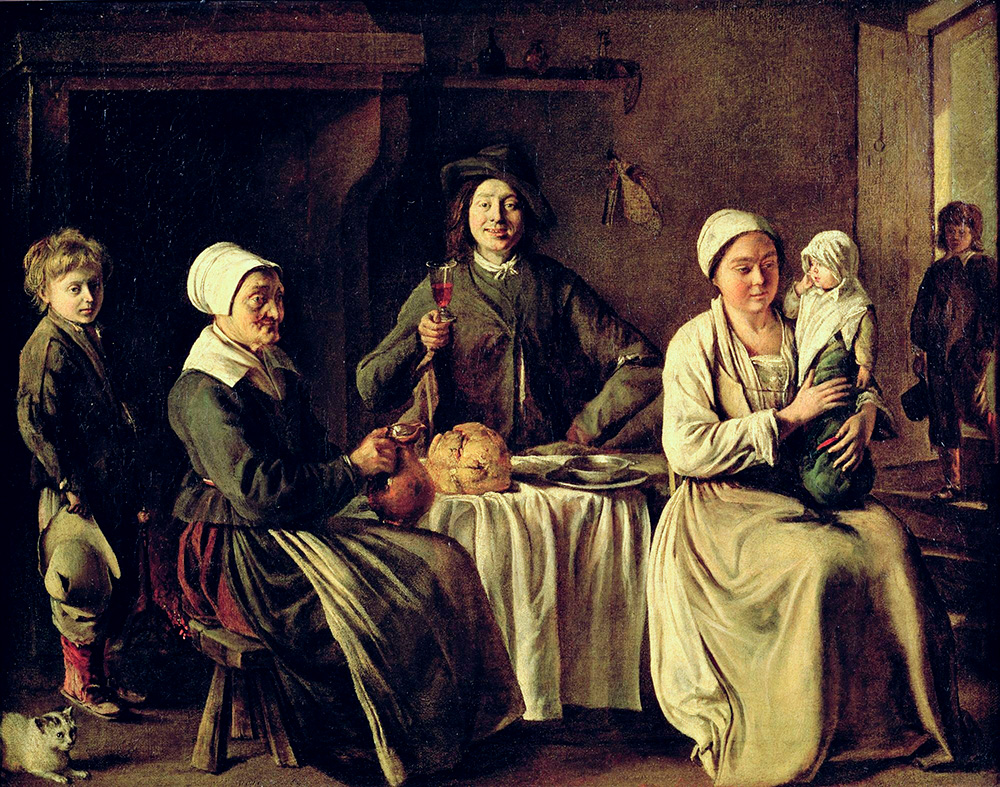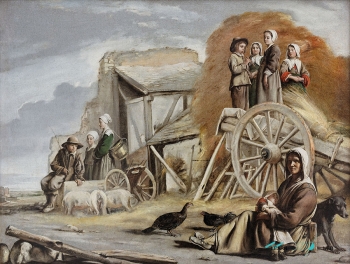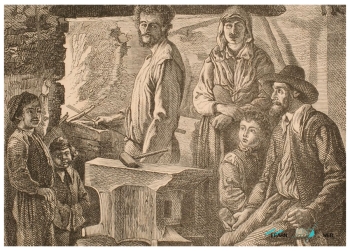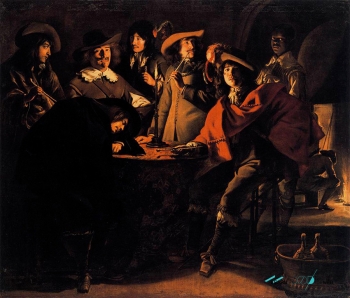
The brothers Antoine, Louis and Mathieu Le Nain, born in Laon, France, between 1593 and 1607, are emblematic figures of 17th century French painting. Sons of Isaac Le Nain, a royal sergeant, and Jehanne Prévost, from a well-to-do family, their exact dates of birth and details about their artistic training remain uncertain due to the destruction of historical records. However, it is believed that they may have learned their craft from a foreign painter, probably Flemish, given the affinity of their style with artists such as Pieter van Laer (known as "il Bamboccio") and the Teniers.
In 1630, the brothers settled in Paris, living together in the rue Princesse. Antoine had been admitted as a "master painter" at Saint-Germain-des-Prés in 1629 and opened a workshop where Louis and Mathieu worked as "companions". This abbey housed a colony of Flemish painters, which may have influenced his style and choice of subjects.
From 1641, his works began to be signed simply as "Le Nain fecit", without specifying the first name, which has made individual attribution of his works difficult and has generated scholarly debates about the authorship of each work. According to Canon Claude Leleu, each brother had distinct specialties:
Antoine: excelled in miniatures and perspective portraits.
Louis: He excelled in half-length portraits and busts.
Mathieu: He specialized in large religious compositions, battle scenes and mythological subjects.
However, their close collaboration meant that these distinctions were not always clear in his works.

The Works and Themes of the Le Nain Brothers
It is estimated that the brothers produced more than 2,000 paintings, although only about 75 are officially recognized today. Their works encompass genre scenes, portraits, religious and mythological scenes. Among the most frequent subjects are scenes of peasant life, known as "bambochadas a la francesa". These paintings transcend the conventional style of the time, focusing on expressing the dignity and inner life of the characters, and establishing a deep connection between the work and the viewer.
The masterpiece, according to Jacques Thuillier, is "The Peasant Family" from the Louvre Museum. This painting, rediscovered in 1914 and acquired by the Louvre in 1915, is an emblematic example of how the Le Nain captured "the essential poem of land and time." Their paintings reflect an intimate knowledge of rural life and the landscapes of Laonnois, the region where they owned property and which they frequented.

Influence and Diffusion through Engraving
The popularity of the Le Nain brothers was greatly enhanced by the work of the engravers of the time. Artists such as Robert-Dumesnil and Jean Pesne transferred their paintings to engravings, allowing a wider dissemination of their art in an era without photography or modern printing. These prints played a crucial role in preserving and spreading their influence beyond Paris and France, reaching art lovers and collectors throughout Europe.
Later printmakers sought to emulate the Le Nain's distinctive style, skillfully reproducing the richness of their pictorial works in the more restrained format of etching. In addition, the brothers helped elevate printmaking to the status of a noble art, establishing a tradition that would influence many later artists. Their mastery of technique helped shape the evolution of this form of expression over the centuries.

Decline and Rediscovery
The triumph of classicism with Nicolas Poussin and the influence of the "Rubenists" at the Royal Academy of Painting and Sculpture quickly eclipsed the notoriety of the Le Nain in the second half of the 17th century. Critics such as André Félibien downplayed his work, calling it "not very noble" and with "simple and not very beautiful" subjects.
In the 18th century, his works were mistaken for Dutch productions and lost interest among collectors. It was not until the 19th century that the critic Champfleury rescued the three brothers from oblivion, highlighting their attachment to their homeland and their importance in French painting. Their work influenced realist artists such as Gustave Courbet and Jean-Baptiste-Camille Corot, and even Paul Cézanne is said to have meditated at length before their works.
Modern research, including technical and scientific analysis, has attempted to distinguish the brothers' hands in their works, but their intimate collaboration and the fusion of their styles make this challenge complex. Recent exhibitions, such as "The Le Nain Mystery" at the Louvre-Lens in 2017, have revived interest in their oeuvre, grouping paintings according to tentative stylistic characteristics of each brother, though without definitive attributions.
The Le Nain legacy is a testament to their ability to capture the human essence and social realities of their time. Their focus on the daily life of the working class provides valuable insight into 17th century French society and constitutes a visual archive rich in historical detail.
El Autor



